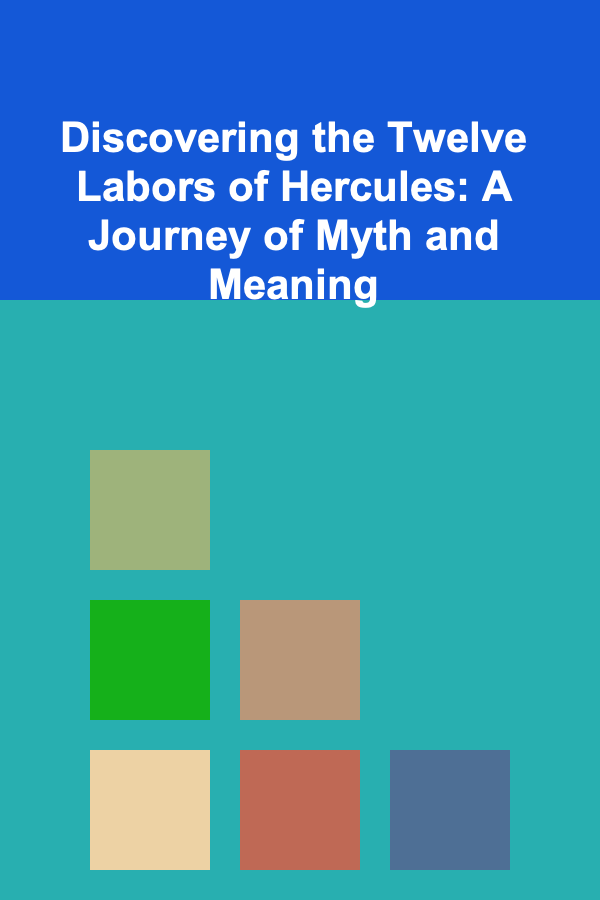
Discovering the Twelve Labors of Hercules: A Journey of Myth and Meaning
ebook include PDF & Audio bundle (Micro Guide)
$12.99$6.99
Limited Time Offer! Order within the next:

The Twelve Labors of Hercules, also known as Heracles in Greek, are a cornerstone of Greek mythology. More than just a series of fantastical adventures, they represent a profound exploration of human potential, redemption, and the struggle against seemingly insurmountable odds. To "discover" these labors is not simply to recount the tales, but to understand their deeper symbolic meaning and their enduring relevance to the human condition. This essay will delve into each labor, exploring their narrative details, thematic significance, and potential interpretations for the modern reader.
The Context: A Hero's Torment and a Goddess's Wrath
Before embarking on the labors, it's crucial to understand the context that gave rise to them. Hercules, son of Zeus and the mortal Alcmene, was blessed with extraordinary strength and courage, but also burdened by a tragic fate. Hera, Zeus's jealous wife, relentlessly pursued Hercules with her hatred, culminating in a moment of madness inflicted upon him. Driven insane, Hercules murdered his wife Megara and their children. Awaking to the horror of his actions, he sought atonement for his crime.
The Oracle at Delphi, speaking on behalf of Apollo, decreed that Hercules must serve King Eurystheus of Tiryns for twelve years, performing whatever tasks the king commanded. Eurystheus, a weak and cowardly ruler, delighted in assigning Hercules tasks that seemed impossible, hoping to bring about the hero's demise. These tasks became known as the Twelve Labors, a series of trials that tested Hercules's strength, cunning, and endurance to their absolute limits.
Labor 1: Slaying the Nemean Lion
The first labor tasked Hercules with slaying the Nemean Lion, a beast with impenetrable skin. Arrows and swords were useless against it. Hercules eventually tracked the lion to its lair, trapped it, and wrestled it to death. He then used the lion's own claws to skin it, creating an impenetrable cloak that he wore for the remainder of his labors.
Symbolic Significance: The Nemean Lion represents primal, untamed forces within the self and the world. Hercules's victory symbolizes the conquering of these base instincts and the development of self-control. The lion's skin, serving as armor, represents the protection gained through overcoming internal and external challenges.
Labor 2: Slaying the Lernaean Hydra
The Lernaean Hydra was a multi-headed serpent with poisonous breath. Every time one head was cut off, two more would grow in its place. Furthermore, a giant crab assisted the Hydra in its defense. With the help of his nephew Iolaus, Hercules solved the problem. Iolaus cauterized the neck stumps with a burning torch after Hercules severed each head, preventing new heads from growing. Hercules then dipped his arrows in the Hydra's poisonous blood, making them deadly.
Symbolic Significance: The Hydra symbolizes the persistence of negativity and the cyclical nature of challenges. The act of cutting off one head and having two grow back represents the frustrating tendency for problems to multiply despite our efforts. Iolaus's use of fire symbolizes reason and the application of knowledge to stop the cycle of negativity. The Hydra's venom represents the insidious power of negativity to poison our lives.
Labor 3: Capturing the Ceryneian Hind
The Ceryneian Hind was a golden-horned deer sacred to Artemis, the goddess of the hunt. It was incredibly swift, and Hercules was tasked with capturing it alive, without harming it. After a year-long chase, Hercules finally cornered the hind and captured it, either with a net or by exhausting it. He then had to appease Artemis for violating her sacred animal.
Symbolic Significance: The Ceryneian Hind represents aspirations, unattainable goals, or things held sacred. The year-long chase symbolizes the dedication and perseverance required to achieve challenging goals. Capturing the hind without harming it represents the need for respect and consideration when pursuing our ambitions. The appeasement of Artemis highlights the importance of maintaining balance and respecting boundaries in our pursuit of success.
Labor 4: Capturing the Erymanthian Boar
The Erymanthian Boar was a monstrous boar that terrorized the region around Mount Erymanthus. Hercules was tasked with capturing it alive. He drove the boar into deep snow, where it became trapped, and then bound it and carried it back to Eurystheus.
Symbolic Significance: The Erymanthian Boar represents uncontrolled rage, destructive impulses, and the chaos they unleash. The act of driving the boar into the snow symbolizes gaining control over these impulses by isolating them. Binding the boar represents the restraint and discipline required to manage destructive emotions.
Labor 5: Cleaning the Augean Stables
The Augean Stables housed the cattle of King Augeas and had not been cleaned for many years. The sheer volume of dung made the task seem impossible. Hercules diverted two rivers through the stables, washing them clean in a single day.
Symbolic Significance: The Augean Stables represent accumulated negativity, stagnation, and the burdens of the past. The sheer volume of dung symbolizes the overwhelming nature of unresolved issues and negative emotions. Diverting the rivers represents the power of innovative thinking and the cleansing force of change. This labor highlights the importance of confronting and clearing away accumulated baggage to move forward.
Labor 6: Slaying the Stymphalian Birds
The Stymphalian Birds were man-eating birds with bronze beaks, claws, and wings. They infested the marshes of Stymphalus, polluting the air and devouring anything they could catch. Hercules, with the help of Athena, received a bronze rattle (or castanets) which he used to scare the birds into the air, where he shot them down with his arrows.
Symbolic Significance: The Stymphalian Birds represent negative thoughts, anxieties, and harmful influences that cloud our minds and poison our environment. The bronze rattle symbolizes the use of knowledge, skills, or tools to disrupt these negative patterns. Shooting the birds down represents the act of actively confronting and eliminating these harmful influences.
Labor 7: Capturing the Cretan Bull
The Cretan Bull was a magnificent, but ferocious bull that belonged to King Minos of Crete. Hercules was tasked with capturing it and bringing it back to Eurystheus. Hercules wrestled the bull into submission and brought it back to Greece.
Symbolic Significance: The Cretan Bull represents untamed passion, raw power, and the potential for both creation and destruction. Wresting the bull into submission symbolizes gaining control over our emotions and channeling our energy in a constructive direction. This labor emphasizes the importance of harnessing our inner strength for positive purposes.
Labor 8: Stealing the Mares of Diomedes
Diomedes, a king of Thrace, owned a herd of mares that fed on human flesh. Hercules sailed to Thrace, killed Diomedes, and drove the mares back to Eurystheus. The mares were eventually set free or sacrificed to Hera.
Symbolic Significance: The Mares of Diomedes represent destructive addictions, consuming desires, and the consequences of unchecked indulgence. Diomedes represents the controlling force that perpetuates these harmful habits. Killing Diomedes symbolizes breaking free from the grip of addiction and taking control of our lives. Setting the mares free represents the release of these destructive forces, allowing us to move towards healing and recovery.
Labor 9: Obtaining the Girdle of Hippolyta
Hippolyta was the queen of the Amazons, a tribe of warrior women. She possessed a magnificent girdle (belt) that was a symbol of her power. Hercules was tasked with obtaining this girdle for Eurystheus's daughter. After some initial trust, Hera stirred up trouble, leading to a battle between Hercules and the Amazons. Hercules killed Hippolyta and took the girdle.
Symbolic Significance: The Girdle of Hippolyta represents power, authority, and the feminine principle. Hippolyta represents the strength and independence of women. The labor can be interpreted in various ways. One interpretation sees the girdle as representing the challenges of understanding and relating to the feminine aspect of ourselves (for men) or embracing our own power and independence (for women). The conflict and acquisition of the girdle can symbolize the struggle for balance and understanding between masculine and feminine energies.
Labor 10: Obtaining the Cattle of Geryon
Geryon was a three-bodied giant who owned a herd of magnificent red cattle. Hercules had to travel to the far west, beyond the Pillars of Hercules (Strait of Gibraltar), to reach Geryon. He killed Geryon and his herdsman and brought the cattle back to Eurystheus.
Symbolic Significance: Geryon represents greed, excess, and the dangers of material wealth. The three bodies can symbolize the multiple facets of greed and its insatiable nature. The journey to the far west represents the challenges and sacrifices required to overcome the allure of materialism. Killing Geryon symbolizes the rejection of greed and the pursuit of a more meaningful life. The cattle represent the rewards of hard work and the value of genuine accomplishment.
Labor 11: Obtaining the Apples of the Hesperides
The Apples of the Hesperides were golden apples guarded by the Hesperides, nymphs who lived in a garden at the edge of the world, and a hundred-headed dragon named Ladon. Hercules had to discover the location of the garden and find a way to obtain the apples. He eventually sought the help of Atlas, who held up the sky. Hercules offered to hold the sky while Atlas retrieved the apples. When Atlas returned, he was reluctant to take the sky back. Hercules tricked him into holding it for a moment, and then snatched the apples and left.
Symbolic Significance: The Apples of the Hesperides represent wisdom, immortality, and the attainment of higher knowledge. The garden represents a place of perfection and enlightenment. The Hesperides and Ladon symbolize the guardians of this knowledge and the obstacles that must be overcome to reach it. Atlas represents the burden of responsibility and the limitations of the physical world. Hercules's trickery symbolizes the need for cunning and resourcefulness in the pursuit of knowledge. This labor highlights the importance of seeking wisdom and overcoming challenges to attain enlightenment.
Labor 12: Capturing Cerberus
The final labor was the most daunting: capturing Cerberus, the three-headed dog who guarded the gates of the Underworld. Hercules had to descend into the Underworld, obtain permission from Hades (or Persephone in some accounts), and subdue Cerberus without using weapons. Hercules wrestled Cerberus into submission and brought him to Eurystheus, before returning him to the Underworld.
Symbolic Significance: Cerberus represents fear, death, and the unknown aspects of the unconscious mind. The descent into the Underworld symbolizes confronting our deepest fears and shadows. Obtaining permission from Hades represents the need to acknowledge and accept the inevitability of death and the darker aspects of our nature. Wrestling Cerberus into submission without weapons symbolizes the power of inner strength and courage in overcoming fear. This labor highlights the importance of facing our fears and integrating the shadow self to achieve wholeness.
Beyond the Labors: Hercules's Legacy
The Twelve Labors are not just a series of fantastical adventures; they are a journey of self-discovery, redemption, and the triumph of the human spirit. Through each labor, Hercules confronts and overcomes challenges that represent the struggles we all face in life: controlling our impulses, overcoming negativity, pursuing our goals, and confronting our fears.
Hercules's story continues beyond the labors. He goes on to perform other heroic deeds, eventually achieving immortality and ascending to Olympus. His life is a testament to the potential for growth, transformation, and the enduring power of the human spirit to overcome adversity.
Interpreting the Labors Today:
The Twelve Labors of Hercules offer a rich tapestry of meaning that resonates with contemporary audiences. Here are some ways to interpret them in the modern context:
- Personal Growth: The labors can be seen as a roadmap for personal growth and development. Each labor represents a specific challenge or obstacle that we must overcome to reach our full potential. * Overcoming Addiction: Several of the labors, such as the Mares of Diomedes, can be interpreted as metaphors for overcoming addiction and destructive habits. * Managing Emotions: The Erymanthian Boar and the Cretan Bull represent the importance of managing our emotions and channeling our energy in a constructive way. * Environmentalism: The Augean Stables and the Stymphalian Birds can be seen as metaphors for environmental pollution and the need to clean up our act. * Facing Fears: The final labor, the capture of Cerberus, represents the importance of facing our fears and integrating the shadow self.
Conclusion:
To truly "discover" the Twelve Labors of Hercules is to embark on a journey of self-discovery. By understanding the narrative details, symbolic significance, and potential interpretations of each labor, we can gain valuable insights into our own lives and the challenges we face. The story of Hercules reminds us that even in the face of seemingly insurmountable odds, we have the potential to overcome adversity, achieve our goals, and live a more meaningful life. The labors are a powerful testament to the enduring power of the human spirit and the ongoing quest for self-improvement.
The myth of Hercules and his Twelve Labors remains a timeless and potent source of inspiration, urging us to embrace our own inner strength, confront our challenges with courage, and strive for a life of purpose and meaning. By understanding the symbolic richness embedded within these ancient tales, we can unlock their potential to guide and illuminate our own personal journeys.

Essential Skills for the Technical Support Engineer: A Comprehensive Handbook
Read More
How to Budget for a Baby Without Going Over Your Household Limit
Read More
How to Clean and Organize Fishing Gear After Use
Read More
How to Market Your IT Consulting Services Effectively
Read More
How to Understand Depth of Field
Read More
How to Use Color-Coded Binders for School and Work Documents
Read MoreOther Products

Essential Skills for the Technical Support Engineer: A Comprehensive Handbook
Read More
How to Budget for a Baby Without Going Over Your Household Limit
Read More
How to Clean and Organize Fishing Gear After Use
Read More
How to Market Your IT Consulting Services Effectively
Read More
How to Understand Depth of Field
Read More